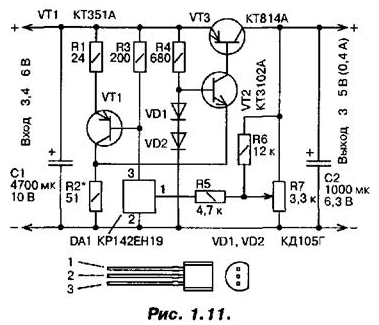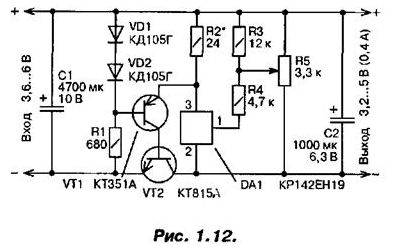
|
|
ENCYCLOPEDIA OF RADIO ELECTRONICS AND ELECTRICAL ENGINEERING Low voltage voltage regulator, 3,4-6/3-5 volts 0,4 amps. Encyclopedia of radio electronics and electrical engineering
Encyclopedia of radio electronics and electrical engineering / Surge Protectors Despite the fact that microcircuits of low-voltage (3 ... 5 V) voltage stabilizers with a small voltage drop have now appeared, they are still not very common, especially among radio amateurs. But low-voltage stabilizers are now becoming of particular relevance. Almost all audio players are powered by a 3V supply, many modern radios also require this voltage, not to mention microprocessors. The devices brought to the attention of readers are an attempt to make such low-voltage stabilizers using affordable and inexpensive elements. The circuitry of voltage stabilizers for powering devices with low-voltage power supply has its own peculiarities. For example, the simplest protection of stabilizers is most effective by limiting the maximum load current at a low output voltage. The voltage drop across the regulating transistor of the stabilizer when the output is closed differs little from the working one and the transistor overheats slightly. It is very important for low-voltage stabilizers to reduce the minimum voltage between the input and output, since this increases not only the efficiency of the equipment, but also its reliability. For example, if a microcircuit is used in a three-volt stabilizer with a voltage drop across it also of three volts, then the rectifier supplying this device should supply voltage, taking into account ripples of about 9 V. If this voltage, due to a breakdown of the microcircuit, hits the load, it is very likely that it will come out out of service. For a stabilizer, on the other hand, the voltage drop across which is less than 0,4 V, an input voltage of about 5 V is enough. A load designed for a three-volt supply is likely to withstand such an overvoltage. Until recently, there was a problem - to choose a source of exemplary voltage for a low-voltage stabilizer - a zener diode. Usually low-voltage zener diodes have very low parameters. The development of relatively simple low-voltage stabilizers, taking into account all of the above, allows the KR142EN19 microcircuit, an integral analogue of a low-voltage zener diode. This chip is available in a plastic case with three pins. When the voltage at its control electrode relative to the anode is less than +2,5 V, the cathode current of the microcircuit does not exceed 1,2 mA, and it depends little on the voltage between the anode and cathode of the microcircuit. As soon as the voltage at the control electrode exceeds the threshold of +2,5 V, the cathode current of the microcircuit increases sharply until the voltage at the cathode drops to 2,5 V. The resistor connected to the cathode must limit this current to a value of no more than 100 mA. The current of the control electrode is very small - a few microamperes, and this current should also be limited, since if it is increased too much, the voltage at the cathode of the microcircuit may increase. Because the microcircuit is an analogue of a zener diode, then in the circuits it is switched on in the same way, in reverse polarity. The voltage at the cathode is always more positive than at the anode. The circuit of a low-voltage voltage regulator on a KR142EN19 microcircuit with a regulating transistor in the positive conductor is shown in fig. 1.11. The voltage drop on this stabilizer does not exceed 0,4 V, and the stabilization coefficient is more than 600.
When the voltage on the output voltage regulator engine (resistor R7) rises to 2,5 V, the DA1 chip opens, which causes the transistor VT1 to open, the transistor VT2 to close, and then the regulating transistor VT3 to close. With the voltage regulator R7, you can set the output voltage less than the 3 V indicated in the diagram up to about 2,6 V, however, during the switching on of the stabilizer, especially without load, a short-term increase in the output voltage to 3 V is possible. This stabilizer can also be adjusted to a voltage of more than 5 V, but then it will overheat greatly when the load is shorted, since it is protected only by limiting the output current, which depends on the resistance of the resistor R2. The maximum operating current increases with a decrease in its rating. If you need to significantly increase the output current of the stabilizer, you can try to reduce the values of the resistors R1 and R2 by the same number of times and use more powerful transistors. In place of VT1, it is permissible to use a transistor of the KT626 series, and VT2 - KT630. We can replace the KT814A (VT3) transistor with any of the KT816, KT837 series with the maximum base current transfer coefficient. The stabilizer should not use emitter followers to increase the output current. This increases the feedback loop time and can lead to excitation. If, nevertheless, self-excitation has arisen, it is necessary to increase the capacitance of capacitors C1 and C2, and also connect a capacitor with a capacity of several hundred picofarads between the cathode and the control electrode of the microcircuit. A variant of a stabilizer with a regulating transistor in the negative conductor is shown in fig. 1.12. When the voltage at the control electrode rises to +2,5 V relative to the anode, the microcircuit opens and closes the transistors VT1 and VT2. The maximum operating current is set by selecting the resistor R2.
In the described devices, somewhat unusual output voltage dividers are used, in contrast to the traditional one, when a variable resistor is included in the upper arm according to the circuit. In this case, if the contact in the circuit of the variable resistor engine is broken, the voltage at the output of the stabilizers can only decrease, while when using a traditional divider, the output voltage reaches its maximum level, which can damage the load. In both stabilizers described above, in order to reduce the dependence of the maximum operating current on temperature, it is useful to provide thermal contact between the diodes VD1, VD2 and the heat sink of the regulating transistor. If such stabilizers are used as adjustable, it is useful to include constants in series with variable resistors (to each extreme terminal). Their resistances should be selected so that the limits for adjusting the output voltage correspond to those indicated in the diagrams. In the absence of such resistors, the stabilizers can exit the stabilization mode in the extreme positions of the engines. Author: Semyan A.P.
Artificial leather for touch emulation
15.04.2024 Petgugu Global cat litter
15.04.2024 The attractiveness of caring men
14.04.2024
▪ UAVOS drone with record run time ▪ LP3883 CMOS Voltage Regulator ▪ Rosewill PB240-RGB Liquid Cooling System ▪ Artificial intelligence will help you choose a recipe
▪ section of the site Car. Article selection ▪ Armageddon article. Popular expression ▪ article How do we know what is at the center of the Earth? Detailed answer ▪ article by Aktey. Legends, cultivation, methods of application
Home page | Library | Articles | Website map | Site Reviews www.diagram.com.ua |






 Arabic
Arabic Bengali
Bengali Chinese
Chinese English
English French
French German
German Hebrew
Hebrew Hindi
Hindi Italian
Italian Japanese
Japanese Korean
Korean Malay
Malay Polish
Polish Portuguese
Portuguese Spanish
Spanish Turkish
Turkish Ukrainian
Ukrainian Vietnamese
Vietnamese


 Leave your comment on this article:
Leave your comment on this article: